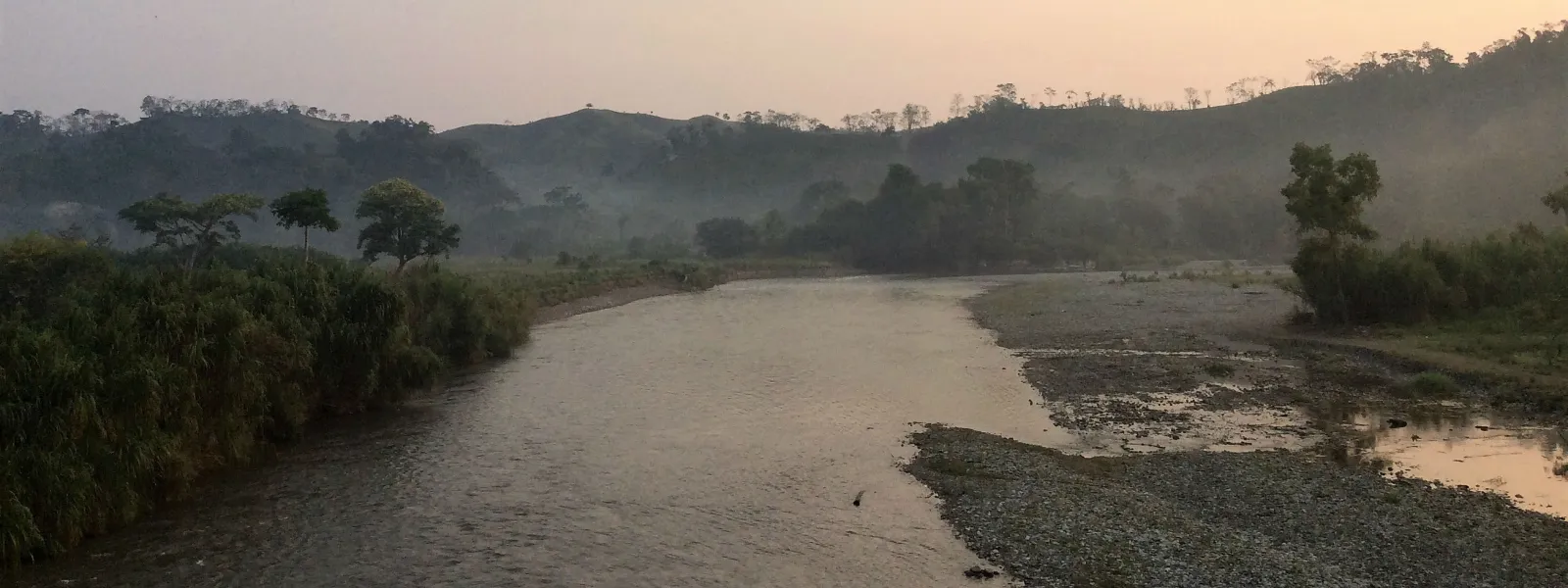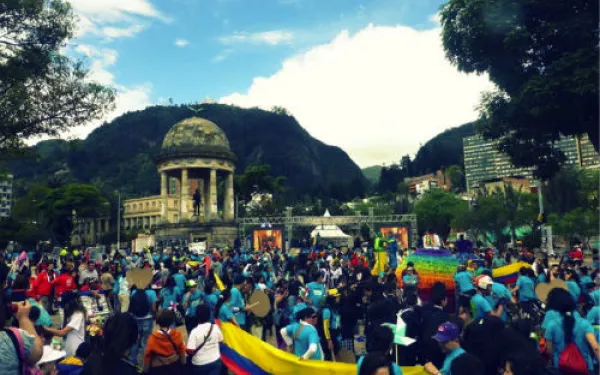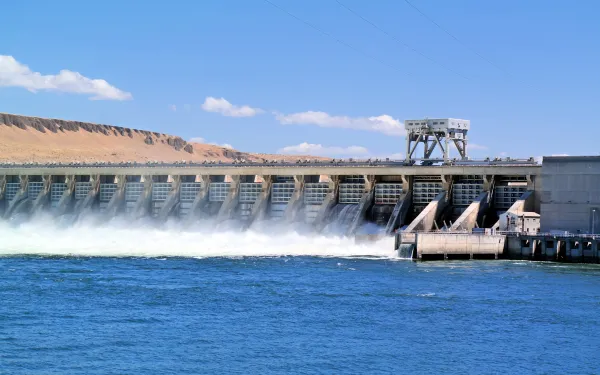
Project
Liliana Ávila /AIDAMayan women’s struggle before the Inter-American Development Bank in Guatemala
Mayan communities succeeded in getting the IDB Invest to develop a responsible exit plan after withdrawing its financing for two hydroelectric projects that negatively impacted ecosystems and the livelihoods of indigenous peoples, especially women, in the micro-region of Yichk'isis (Ixquisis).
In the struggle to defend their water, territory and way of life, indigenous Mayan communities in the Yichk'isis (Ixquisis) micro-region of northern Guatemala convinced the Inter-American Development Bank Group to withdraw its financing of two hydroelectric dams whose implementation violated their rights. The decision was also significant in that the IDB, for the first time, designed a responsible exit plan.
That historic advance was the result of the complaint that the communities filed in August 2018—with the support of AIDA, the Plurinational Ancestral Government of the Akateko, Chuj, and Q'anjob'al Native Nations, and the International Platform against Impunity. The complaint was filed with the Independent Consultation and Investigation Mechanism (MICI), the IDB Group's accountability office.
In resolving the case in September 2021, the MICI concluded that IDB Invest failed to comply with its own operational policies and safeguards, in the framework of the financing granted to the company Energía y Renovación S.A. for the implementation of the San Mateo and San Andrés hydroelectric projects.
Learn more about this achievement
In the mountains of Northwestern Guatemala, near the border with Mexico, the land is rich and fertile. Several important rivers and many other water sources feed the soil.
The residents of these mountains, many indigenous women of Mayan descent, have long depended on the waters to nourish them, to provide them with fish, as well as for agriculture, sanitation, and cooking.
But the construction of the San Mateo and San Andres dams has caused water scarcity and the contamination of rivers and other natural resources long cherished by the communities.
The near lack of water has also drastically reduced harvests, lessening the income gained from selling corn, wheat, beans, coffee, sugar cane and other products in the market. As a result, the conditions of poverty in the area have deepened.
And the risk situation is profound, particularly for women, who have played a very important role in the defense of water and territory threatened by hydroelectric projects, and are therefore victims of intimidation and stigmatization.
As guardians of their land and water, they have come to its defense and they’ll continue to prevent environmental deterioration from further harming their families.
Read our fact sheet on the case

Related projects

Thousands rally in Colombia's capital for Global Climate Action
By Seble Gameda, geographer The sounds of brass instruments, drumming, bike bells, and chants filled the streets of Bogota, Colombia on Sunday, September 21, as over three thousand people bearing banners, posters, flags and face paint, rallied for urgent climate action, as part of the International People's Climate March. "We are making a global petition to the heads of state to make a binding treaty that responds to the climate crisis, and we need national and local governments to commit as well," said Ana Sofía Suarez, Campaign Coordinator with the international citizen’s movement, Avaaz, and Event Coordinator for the People’s Climate March in Bogotá. Over 100 world leaders met in New York City to discuss the climate crisis and carbon emissions reductions, just months prior to the Conference of the Parties (COP) 20 that will take place in Lima, Peru as part of the United Nations Framework Convention on Climate Change. A binding agreement is planned to be signed at COP 21 in Paris in December 2015. The United Nations Climate Summit in New York City also focused on the Green Climate Fund, in which developed countries aim to raise $100 billion per year by 2020 in climate finance, in order to assist developing countries towards "low-carbon, climate resilient development." Hector Herrera, Coordinator of the Colombian Environmental Justice Network, spoke to the importance of developing countries participating in the climate marches, stating that "although the global north is primarily responsible for climate change, we in the global south are most affected, and less prepared to adapt to a changing climate." Demonstrations were organized worldwide to show the power of the people’s climate movement. "We are the first generation that is really aware of climate change, but we are the last that can do something about it," stated Juan David García, an organizer with the grassroots environmental organization 350.org. Bogotá’s Climate March was filled with diversity; artists, professors, youth, bankers, cyclists, the elderly. As Suarez commented, "in these spaces when everyone comes together, you begin to realize that you are not alone, that we are among many who are dreaming of something different, and if we begin to demand changes, then we can make this dream happen." Climate change is no longer just an isolated issue of scientists and environmentalists, we are reaching a critical mass, showing once again that protest is powerful; it is the movement of people that makes change: anti-war, civil rights, healthcare, education, and … climate justice.
Read more
Open letter to governments, international institutions and financial mechanisms to stop considering large dams as clean energy and to implement real solutions to climate change
57 CIVIL SOCIETY ORGANIZATIONS AND COALITIONS IN LATIN AMERICA INSIST THAT LARGE DAMS ARE NOT CLEAN ENERGY SOURCES AND WE ASK GOVERNMENTS, INTERNATIONAL ORGANIZATIONS AND FINANCIAL INSTITUTIONS TO IMPLEMENT REAL SOLUTIONS TO CLIMATE CHANGE It is time to learn from the past and to implement alternatives appropriate to our time According to the World Commission on Dams, by the year 2000, fifty thousand dams had already been built, disrupting more than 60% of Earth’s rivers.[1] In Latin America alone, 973 dams of all sizes are operating, and roughly 1,600 more are being built or planned—254 in the Amazon Basin.[2] Scientific evidence reveals that large dams: emit greenhouse gases, including methane, especially in tropical regions,[3] aggravating climate change, and making adaptation more difficult; cost almost twice their initial budget, causing economic difficulties in the communities and countries where they are implemented;[4] take a long time to become operational, making them an inefficient solution to the urgent energy crisis that they are intended to tackle;[5] may cause great and irreparable environmental damage; and may cause human rights violations and impoverishment of communities if not implemented with appropriate safeguards. Nevertheless, they continue to be promoted as clean energy sources to meet increasing energy demand.[6] Why are dams not clean energy sources and why are alternatives needed? 1. Because they contribute to climate change and make adaptation more difficult Construction and operation of large dams in tropical regions causes emission of CO2 and methane from the large amounts of flooded and retained organic matter in reservoirs. The greenhouse gas effect of methane is between 20 to 40 times more powerful than that of CO2.[7] Dams also destroy large areas of surrounding lands needed to build them. Dams are not flexible enough to endure climate change. On the contrary, they are inefficient in droughts and unsafe in floods, which aggravates the risk of disasters. Moreover, they threaten communities’ entire hydrologic system, destroying key ecosystems and fisheries, thus compromising communities’ ability to adapt to climate change. 2. Because of the cost overruns, delays and economic damage that they entail Data show that the final cost of the majority of dams that have been built is 96% greater than their initial budgets. This expense has been linked to the increase of public debt and to economic crisis in several countries.[8] 3. Because they take a long time to become operational, making them an inefficient solution to the urgent energy crisis that they are intended to tackle Construction of large dams takes approximately 8.6 years, plus time to begin operating,[9] and they operate on average only 50 years.[10] Experts have documented that eight out of every ten dams exceed their initial construction-time estimates by more than 44%.[11] Dams are not an efficient solution to growing and urgent energy demand. 4. Because they may cause great and irreparable environmental damage Large dams cause environmental damages to rivers, hydrologic basins and surrounding ecosystems, including: worsening water quality in rivers; degradation of aquatic ecosystems and disappearance of many riparian ecosystems; and serious harms to biodiversity, including the extinction of species.[12] 5. Because environmental damage may violate human rights and impoverish communities The human rights of the people affected by large dams have been systematically unrecognized. Large dams have caused forced displacement;[13] health problems; loss of food sources and traditional ways of life; community impoverishment;[14] and criminalization of social protest. Additionally, permitting processes are generally flawed; permits are issued without comprehensive environmental or social impact assessments, and without adequate public participation and consultation. TODAY there are cleaner, more efficient, less costly and faster alternatives to respond to energy demand. Therefore we DEMAND that Governments, international organizations and financial institutions immediately: Stop considering large dams as clean energy sources, given the proved negative impacts mentioned above. These impacts must be considered comprehensively. Incorporate in the planning stage for new dams: scientific evidence of greenhouse gas emissions, including methane produced by reservoirs; the instability that climate change causes in the hydrologic regime; lessons learned regarding costs and real implementation time of large dams; comprehensive evaluation of environmental and social impacts that will be caused; an integrated, realistic energy strategy through a Comprehensive Plan for Electric Sector Energy Resources; Make decisions that account for impacts on the environment, human rights and climate change. Implement real energy solutions that prove to be effective, with benefits that outweigh the harms they cause. Adopt inclusive and transparent decision-making processes, taking into account the whole spectrum of energy alternatives. Abogadas y Abogados para la Justicia y los Derechos Humanos, A.C., México Alianza de Comunidades y Usuarios en Defensa del Río Biobos-Nautla, México Alianza para la Conservación y el Desarrollo (ACD), Panamá Amazon Watch, Estados Unidos Amazónicos por la Amazonía (AMPA), Perú Amigos del Río San Rodrigo, México Asamblea Veracruzana de Iniciativas y Defensa Ambiental (LAVIDA), México Asociación Ambiente y Sociedad, Colombia Asociación Amigos de los Parques Nacionales (AAPN), Argentina Asociación Ceiba, Guatemala Asociación de Ecología Social (AESO), Costa Rica Asociación Interamericana para la Defensa del Ambiente (AIDA), Regional Asociación Palmareña para la Recuperación del Ambiente (APRA), Costa Rica Asociación Peruana para la Conservación de la Naturaleza, Perú Asociación Pro Derechos Humanos (APRODEH), Perú Asociación Proyectos Alternativos para Desarrollo Social (PROAL), Costa Rica Bloque Verde, Costa Rica Centro de Desarrollo Étnico (CEDET), Perú Centro de Documentación en Derechos Humanos “Segundo Montes Mozo S.J.” (CSMM), Ecuador Centro de Estudios para la Justicia Social "Tierra Digna", Colombia Centro de Promoción y Defensa de Derechos Humanos Arequipa (CEPRODEH), Perú Centro Humboldt, Nicaragua Centro Mexicano de Derecho Ambiental, A.C. (CEMDA), México Centro para la Sostenibilidad Ambiental de la Universidad Peruana Cayetano Heredia (CSA-UPCH), Perú Colectivo Defensa Verde Naturaleza para Siempre, México Comisión de Derechos Humanos de Ica, Perú Comisión Ecuménica de Derechos Humanos (CEDHU), Ecuador Comité por los Derechos en América Latina (CEDHAL), Canadá Consejo de Ejidos y Comunidades Opositores a la Presa La Parota (CECOP), México Coordinadora de Afectados por Embalses y Trasvases (COAGRET), España Coordinadora Nacional de Derechos Humanos, Perú Derechos Humanos y Medio Ambiente, Perú Ecologia E Ação (ECOA), Brasil Federación Ecologista de Costa Rica (FECON), Costa Rica Finca Amalur, Costa Rica Fiscalía del Medio Ambiente (FIMA), Chile Foro Ciudadano de Participación por la Justicia y los Derechos Humanos (FORO), Argentina Fórum Solidaridad Perú, Perú Fundación Centro de Derechos Humanos y Ambiente (CEDHA), Argentina Fundación Ecuménica para el Desarrollo y la Paz (FEDEPAZ), Perú Fundación GaiaPacha, Bolivia Fundación POPOL NA, Nicaragua Fundar, México Grupo Ecologista Cuña Pirú, Argentina Instituto Madeira Vivo (IMV), Brasil International Rivers, Estados Unidos JASS, Asociadas por lo Justo, México Justicia para la Naturaleza, Costa Rica María Esperanza Alonso, especialista de Derecho Ambiental, Argentina Movimiento Ciudadano frente al Cambio Climático (MOCICC), Perú Oilwatch Mesoamérica, Costa Rica Plataforma Interamericana de Derechos Humanos, Democracia y Desarrollo (PIDHDD Regional), Ecuador Programa Chile Sustentable, Chile Pueblos Unidos de la Cuenca Antigua por los Ríos Libres, México Red Jurídica Amazónica (RAMA), Bolivia Sociedad Peruana de Derecho Ambiental (SPDA), Perú Unión Norte por la Vida, Costa Rica For more information: AIDA on dams: http://www.aida-americas.org/es/project/grandesrepresas International Rivers: http://www.internationalrivers.org/ Report: Grandes Represas en América: ¿Peor el Remedio que la Enfermedad? Blog: Desmantelando el mito de las represas, Grandes represas elefantes blancos, Hydropower Will Not Solve All Africa's Problems [1] World Commission on Dams Report. http://www.internationalrivers.org/files/attached-files/world_commission_on_dams_final_report.pdf [2] State of the World’s Rivers. http://www.internationalrivers.org/worldsrivers/ [3]2013 IPCC Supplement to the 2006 Guidelines for National GHG Inventories: Wetlands http://www.ipcc-nggip.iges.or.jp/public/wetlands/ [4]Ansar, Atif and Flyvbjerg, Bent and Budzier, Alexander and Lunn, Daniel, Should We Build More Large Dams? The Actual Costs of Hydropower Megaproject Development (March 10, 2014). Energy Policy, March 2014, pp.1-14. [5] Ibid [6] Directions for the World Bank Group’s Energy Sector. http://www.worldbank.org/content/dam/Worldbank/document/SDN/energy-2013-0281-2.pdf [7] Climate and Clear Air Coalition. Short-Lived Climate Pollutants. (2011). http://www.unep.org/ccac/ShortLivedClimatePollutants/tabid/101650/Default.aspx. [8] Ansar, A et al. Furthermore, the Brazilian Federal Court of Accountability carried out a study of the energy projects developed between 2005 and 2012, and it concluded that almost 80% of dams will not comply with their schedule. http://oglobo.globo.com/economia/tcu-constata-atrasos-nas-obras-de-energia-leiloadas-pelo-governo-de-2005-2012-13822128 (Spanish) [9] Ansar, A., et al. [10] Friends of the Earth, et al. Dam Removal Success Stories. (1999). http://www.michigandnr.com/publications/pdfs/fishing/dams/SuccessStoriesReport.pdf http://www.teachengineering.org/view_lesson.php?url=collection/cub_/lessons/cub_dams/cub_dams_lesson08.xml [11] Ansar, A., et al. [12] AIDA. Grandes Represas en América: ¿Peor el remedio que la enfermedad? http://www.aida-americas.org/sites/default/files/InformeAIDA_GrandesRepreseas_BajaRes_1.pdf (Spanish) [13] According to the World Commission on Dams, between 40 and 80 million people have been displaced due to big dams—approximately one out of every 100 people alive today. [14] Thayer Scudder, California Institute of Technology, promoted construction of dams for 58 years, believing that they were an option for the relief of poverty. He publicly changed his mind when he was 84 years old, declaring that they are not worth their cost and that many of the dams currently under construction will have disastrous consequences. New York Times. http://www.nytimes.com/2014/08/24/opinion/sunday/large-dams-just-arent-worth-the-cost.html?emc=eta1&_r=3
Read moreBrazil secures Belo Monte site, but not human rights of affected people
Time doesn’t stop and, unfortunately, nor does the construction of the Belo Monte Dam. Work is advancing at an impressive rate on the Xingu River, in the Brazilian Amazon; 65% of the dam is complete. As it grows, the ecosystem—and the lives of people living in the area—deteriorates. Construction of the gigantic dam has opened an enormous gash through the thick Amazonian vegetation. Seeing it from the air creates a feeling of helplessness. And on land, it’s frustrating to see that the situation of indigenous peoples, coastal communities, and residents of the city of Altamira worsens. Recently, AIDA lawyers, María José Veramendi Villa and Alexandre Andrade Sampaio, visited the Arara indigenous community, nestled in the Big Bend of the Xingu River. Once Belo Monte dams the river, it will reduce the river’s flow so drastically that fishing, the livelihood of the Arara, will no longer be possible. Furthermore, the Arara will lose the track that leads to their sacred sites. They await the arrival of vehicles and construction of a road and a suitable well, because the quality of drinking water is not the best. In Altamira, the deteriorating situation is similar. Veramendi and Sampaio went there too. Once dam construction began, the population of the city grew massively. This boom has overwhelmed health services and the sanitation system and, worse, led to an increase in cases of sexual violence and human trafficking. Norte Energia, the consortium of government and private enterprises building the dam, has caused pisions among the affected population by paying more for some lands than for others. Many people were forced to sell their homes at a minimum price before they were evicted. And the small cinderblock cubes built for the relocation of displaced families do not qualify as adequate housing. Relocation also involves a change in lifestyle: from fishing to farming or hauling bags of cement. "This frays the social fabric,” explained Veramendi. “We work daily, along with our colleagues in Brazil, to make clear in the country and internationally that what is happening in Belo Monte constitutes human rights violations. We are constantly working to compel the government of Brazil to comply with the precautionary measures issued by the Inter-American Commission on Human Rights." On April 1, 2011, the Commission issued precautionary measures that Brazil should take to protect the life, health, and personal and cultural integrity of indigenous peoples in voluntary isolation; the health of other indigenous communities affected by the project; and demarcation of the ancestral lands of indigenous peoples. Our work, like the work of the human rights and environmental defenders we support in Brazil, is not easy. State security forces guard the construction site and Altamira. "We are surrounded, intimidated and harassed; there is no guarantee for our work," said Sampaio. With your help, we will continue fighting to see that the Belo Monte case progresses with the Commission, and that the Government of Brazil complies with its international human rights obligations rather than use the dam to bolster its electoral campaign at the cost of the environment and human welfare. Follow us on Twitter: @AIDAorg "Like" our page on Facebook: www.facebook.com/AIDAorg
Read more